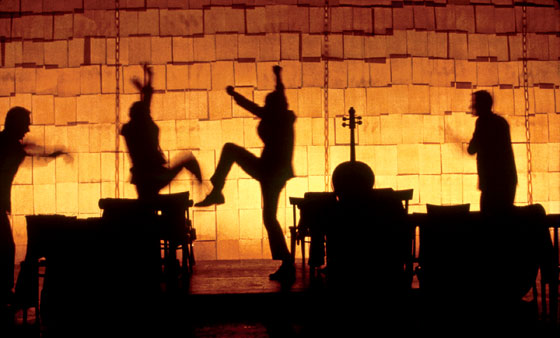
Classical music is global and ephemeral and often aspires to a state of universality: Tonight’s Carnegie Hall recitalist may have just flown in from Germany and will be in Hong Kong next week. Even native New Yorkers hone their acts elsewhere before hoping to return. Which makes an awkward fit for a canon of works linked by their inherent New Yorkiness. I’ve had to wrestle this list into its frame, omitting many memorable musical experiences because they had no special connection to the city, and tying live events to recordings. The New York Philharmonic’s performance of the Brahms Requiem in the days after 9/11 was far too magnificent an event to skip. But I left out Philip Glass’s 1976 Einstein on the Beach; although the premiere seared itself into the memory of those who saw it, the recording tells only half a story. New York creates as much music as it imports, and some of it is imbued with local qualities that materialize only later. In the mid-nineties, Steve Reich walked around Manhattan recording sounds that he later wove into City Life. It’s more explicitly urban than his other works, yet the sense of overlapping rhythms competing in a crowd—the essential sidewalk experience—is equally evident in Drumming, which he wrote more than 30 years earlier. In music, New York sometimes does something supremely un–New Yorky: It hides.
DRUMMING, 1971
Steve Reich was already a charter member of the downtown music scene when he went off to Ghana to study drumming. He returned with a suitcase full of bells and the idea for Drumming, an hour-long-plus all-percussion epic that infused African rhythmic structure with a distinctively New York obsessiveness. A recent CD by the So Percussion ensemble blows away the original version by the composer’s own group.
NEW MUSIC, NEW YORK, 1979
The Soho generation came of age during this weeklong festival of contemporary music at the Kitchen: A tiny audience heard an assortment of mind-altering works by members of the future Establishment, including Meredith Monk’s seminal Dolmen Music. Two decades later, the Kitchen unearthed the tapes and issued a two-CD set: From the Kitchen Archives: New Music New York 1979.
LA BOHÈME, 1981
The principal character in Franco Zeffirelli’s beloved production of La Bohème is Franco Zeffirelli’s production. When it opened at the Met, the second act got a roaring ovation that nearly swamped the singing, and audiences have kept on adoring the director’s snow-globe version of Paris and his hyperdetailed portrayal of festive poverty ever since. The live telecast of that first run, with Teresa Stratas and José Carreras, has been preserved on DVD. There have been few moments so primal in the saga of Met décor.
UNITED STATES I–V, 1983
Laurie Anderson, singer, electric fiddler, artist, wit, and great American raconteuse, tackled the infinite absurdity of American life in a seven-hour, two-night multimedia extravaganza of the sort that only the Brooklyn Academy of Music would have incubated. (The show was condensed into a live double album.) Like many of her Soho compatriots, Anderson developed a coolly ironic delivery, part Andy Warhol, part smartest-kid-in-the-class. In the tones of a science-documentary narrator, she imagined human sperm magnified into sperm whales hurtling from California to Japan. “How would they be received?” she wondered. “Would they know they were carrying information?”
ALFRED BRENDEL’S BEETHOVEN CYCLE, 1983
The pianist Alfred Brendel, scholarly and refined but hardly a box-office name, caused panic in the offices of Carnegie Hall when he announced his plan to play all 32 Beethoven sonatas in one month. It was the first time such a thing had been tried there in 40 years, and staffers envisioned glowing reviews and empty seats. But they had underestimated New York, which turned out to be well supplied with music lovers eager for large doses of Brendel’s lucid, subtle, and un-flashy brand of pianism. The house was full, and the subsequent set of piano sonatas he recorded continues to compete with the two he’d recorded earlier. The Beethoven endurance feat has since become the pianist’s Everest—still formidable, if done a little too often.
THE BANG- ON-A-CAN MARATHON, 1987–PRESENT
Three young composers frustrated by the fragmentation of New York’s musical life—Julia Wolfe, Michael Gordon, and David Lang—organized an event long enough to include music from every stylistic fiefdom and free enough to include all sorts of creative noise. It’s become an annual rite, spawned the crackerjack Bang-on-a-Can All-Stars, and renewed New York’s claim to be a musical incubator with an eclectic soul. (The disciplined excitement of those early sessions comes through on Bang on a Can Live.)
THE ARGUMENT STARTER
PAVAROTTI IN CENTRAL PARK, 1993
From his apartment on Central Park South, Luciano Pavarotti liked to survey the site of his mass-appeal triumph, when half a million people crammed the Great Lawn and millions more tuned in to hear him sing “O Sole Mio.” It was a great moment in branding—for Pavarotti, for opera, and for the park. It’s out on CD and DVD, though those recordings really don’t do him justice—he was always most dazzling indoors and in costume, especially a few blocks away at the Met.
THE DEATH OF KLINGHOFFER, 1991
John Adams’s opera, about the hijacking of the Achille Lauro cruise ship and the murder of a passenger, an appliance manufacturer from New York, touched a nerve when it arrived at the Brooklyn Academy of Music for its U.S. premiere. Jewish organizations protested that Adams had humanized the terrorists, the Klinghoffer family accused the production of being anti-Semitic, and the opera received pained reviews. But it contained ravishing music—not least the aria sung by Klinghoffer as he sinks to his death.
THE DEBUT OF SUPERTITLES, 1983
In 1983, when City Opera introduced supertitles (terse translations projected on a strip of screen above the stage), all operagoers finally understood what was being said. The Met’s James Levine said his company would follow suit “over my dead body.” Twelve years later, in an opening-night performance of Otello, the Met introduced a more private and discreet system of titles on the seat backs, which remains the gold standard. Bonus: That was also the show, now immortalized on DVD, that launched Renée Fleming unto bona fide divadom.
AUDRA MCDONALD, 1998
Audra McDonald had already won three Tonys when she made her first solo CD, and launched it with a killer concert at Joe’s Pub. The set list consisted only of smartly sentimental new music by the new generation of musical-theater composers: Adam Guettel, Michael John LaChiusa, Jason Robert Brown. The event made it clear that big Broadway had more to offer than reheated Lloyd Webber, and McDonald saw herself as a creative muse.
XERXES, 1997
New York is where young opera singers go to temp, and New York City Opera exists in large measure to help them out. Mezzo-soprano Lorraine Hunt Lieberson and countertenor David Daniels arrived for their debuts with ready-made reputations, but their meeting in Handel’s Xerxes made them both stars. They never recorded it together, but each made a CD that includes highlights.
THE EMERSON STRING QUARTET’S SHOSTAKOVICH MARATHON, 2000
When they decided to tackle Shostakovich’s string quartets, the Emerson’s members knew they’d be criticized for not being Russian, soulful, or oppressed enough. Performing all fifteen quartets at Lincoln Center (and recording them), they made a powerful argument that four comfortable New Yorkers knew their way around distress of the soul.
THE PHILHARMONIC’S EIN DEUTSCHES REQUIEM, 2001
A little more than a week after 9/11, the New York Philharmonic opened its season with a performance of Brahms’s German Requiem that rediscovered the depths of succor that classical music can offer. Afterward, audience members didn’t applaud but simply rose in silence and filed out onto Lincoln Center’s plaza, where the final notes of the concert they’d just heard were still playing on a giant screen, and then the scene repeated itself: tears, silence, and the crowd drifting gratefully home.
ZANKEL HALL OPENS, 2003
Dug out of the bedrock beneath Carnegie Hall, the 650-seat Zankel Hall affected the city’s musical life way out of proportion to its size, starting with its inaugural festival curated by John Adams. The concerts had the quality of an inquisitive musician’s CD carousel: wild Latin jazz, medieval motets, high-gloss European avant-garde, and some regular old classical music. It announced that Zankel would be a bazaar of tastes, joined in spirit with the sanctum upstairs. Even the subway rumble that periodically filters in is endearing—after all, it reminds you where you are.
